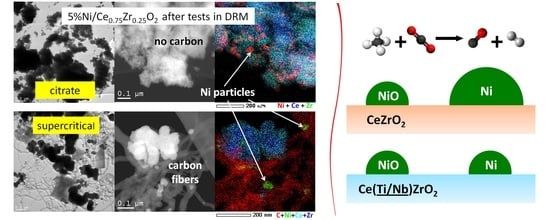Carbon Formation during Methane Dry Reforming over Ni-Containing Ceria-Zirconia Catalysts
Abstract
1. Introduction
2. Materials and Methods
2.1. Catalysts’ Preparation
2.2. Catalysts’ Characterization
2.3. Catalysts’ Testing in Methane Dry Reforming
3. Results and Discussion
3.1. Characterization of Fresh Catalysts
3.1.1. Study of Structure and Texture
3.1.2. Study of Surface Properties by XPS
3.1.3. Study of Surface Sites by FTIR Spectroscopy of Adsorbed CO
3.1.4. Study of Oxygen Mobility by Isotope Exchange with C18O2
3.2. Catalytic Studies in Methane Dry Reforming
3.3. Characterization of Spent Catalysts
3.3.1. Structural and Textural Studies of Spent Catalysts
3.3.2. Study of Spent Catalysts by TEM
3.3.3. Study of Carbon Deposits by TGA
3.4. Long-Term Stability Tests of Catalysts Prepared by Supercritical Synthesis
3.4.1. Long-Term Stability Tests
3.4.2. Study of Carbon Deposits after Long-Term Tests by TGA
4. Conclusions
Supplementary Materials
Author Contributions
Funding
Data Availability Statement
Acknowledgments
Conflicts of Interest
References
- Usman, M.; Daud, W.M.A.W.; Abbas, H.F. Dry reforming of methane: Influence of process parameters—A review. Renew. Sustain. Energy Rev. 2015, 45, 710–744. [Google Scholar] [CrossRef]
- Yentekakis, I.V.; Panagiotopoulou, P.; Artemakis, G. A review of recent efforts to promote dry reforming of methane (DRM) to syngas production via bimetallic catalyst formulations. Appl. Catal. B 2021, 296, 120210. [Google Scholar] [CrossRef]
- Zhang, G.; Liu, J.; Xu, Y.; Sun, Y. A review of CH4-CO2 reforming to synthesis gas over Ni-based catalysts in recent years (2010–2017). Int. J. Hydrog. Energy 2018, 43, 15030–15054. [Google Scholar] [CrossRef]
- Pakhare, D.; Spivey, J. A review of dry (CO2) reforming of methane over noble metal catalysts. Chem. Soc. Rev. 2014, 43, 7813–7837. [Google Scholar] [CrossRef]
- Nikoo, M.K.; Amin, N.A.S. Thermodynamic analysis of carbon dioxide reforming of methane in view of solid carbon formation. Fuel Process. Technol. 2014, 92, 678–691. [Google Scholar] [CrossRef]
- Bradford, M.C.J.; Vannice, M.A. CO2 reforming of CH4. Catal. Rev. 1999, 41, 1–42. [Google Scholar] [CrossRef]
- Erdohelyi, A. Catalytic Reaction of Carbon Dioxide with Methane on Supported Noble Metal Catalysts. Catalysts 2021, 11, 159. [Google Scholar] [CrossRef]
- Makri, M.M.; Vasiliades, M.A.; Petallidou, K.C.; Efstathiou, A.M. Effect of support composition on the origin and reactivity of carbon formed during dry reforming of methane over 5wt%Ni/Ce1−xMxO2−I (M = Zr4+, Pr3+) catalysts. Catal. Today 2016, 259, 150–164. [Google Scholar] [CrossRef]
- Marinho, A.L.A.; Toniolo, F.S.; Noronha, F.B.; Epron, F.; Duprez, D.; Bion, N. Highly active and stable Ni dispersed on mesoporous CeO2-Al2O3 catalysts for production of syngas by dry reforming of methane. Appl. Catal. B 2021, 281, 119459. [Google Scholar] [CrossRef]
- Gao, X.; Lin, W.; Ge, Z.; Ge, H.; Kawi, S. Modification Strategies of Ni-Based Catalysts with Metal Oxides for Dry Reforming of Methane. Methane 2022, 1, 139–157. [Google Scholar] [CrossRef]
- Wang, S.; Lu, G.Q.M. Carbon dioxide reforming of methane to produce synthesis gas over metal supported catalysts: State of the art. Energy Fuels 1996, 10, 896–904. [Google Scholar] [CrossRef]
- Lanre, M.S.; Al-Fatesh, A.S.; Fakeeha, A.H.; Kasim, S.O.; Ibrahim, A.A.; Al-Awadi, A.S.; Al-Zahrani, A.A.; Abasaeed, A.E. Catalytic Performance of Lanthanum Promoted Ni/ZrO2 for Carbon Dioxide Reforming of Methane. Processes 2020, 8, 1502. [Google Scholar] [CrossRef]
- Gadalla, A.M.; Bower, B. The role of catalyst support on the activity of nickel for reforming methane with CO2. Chem. Eng. Sci. 1998, 43, 3049–3062. [Google Scholar] [CrossRef]
- Hu, Y.H.; Ruckenstein, E. Catalytic Conversion of Methane to Synthesis Gas by Partial Oxidation and CO2 Reforming. Adv. Catal. 2004, 48, 297–345. [Google Scholar] [CrossRef]
- Carrero, A.; Calles, J.A.; Vizcaíno, A.J. Effect of Mg and Ca addition on coke deposition over Cu–Ni/SiO2 catalysts for ethanol steam reforming. Chem. Eng. J. 2010, 163, 395–402. [Google Scholar] [CrossRef]
- Kambolis, A.; Matralis, H.; Trovarelli, A.; Papadopoulou, C. Ni/CeO2-ZrO2 catalysts for the dry reforming of methane. Appl. Catal. A 2010, 377, 16–26. [Google Scholar] [CrossRef]
- Charisiou, N.D.; Siakavelas, G.; Tzounis, L.; Sebastian, V.; Monzon, A.; Baker, M.A.; Hinder, S.J.; Polychronopoulou, K.; Yentekakis, I.V.; Goula, M.A. An in depth investigation of deactivation through carbon formation during the biogas dry reforming reaction for Ni supported on modified with CeO2 and La2O3 zirconia catalysts. Int. J. Hydrog. Energy 2018, 43, 18955–18976. [Google Scholar] [CrossRef]
- Wolfbeisser, A.; Sophiphun, O.; Bernardi, J.; Wittayakun, J.; Föttinger, K.; Rupprechter, G. Methane dry reforming over ceria-zirconia supported Ni catalysts. Catal. Today 2016, 277, 234–245. [Google Scholar] [CrossRef]
- Swaan, H.M.; Kroll, V.C.H.; Martin, G.A.; Mirodatos, C. Deactivation of supported nickel catalysts during reforming of methane by carbon dioxide. Catal. Today 1994, 21, 571–578. [Google Scholar] [CrossRef]
- Zhang, Z.L.; Verykios, X.E. Carbon dioxide reforming of methane to synthesis gas over supported Ni catalysts. Catal. Today 1994, 21, 589–595. [Google Scholar] [CrossRef]
- Chen, Y.-G.; Tomishige, K.; Fujirnoto, K. Formation and characteristic properties of carbonaceous species on nickel-magnesia solid solution catalysts during CH4-CO2 reforming reaction. Appl. Catal. A 1997, 161, Ll1–Ll7. [Google Scholar] [CrossRef]
- Fakeeha, A.H.; Kasim, S.O.; Ibrahim, A.A.; Abasaeed, A.E.; Al-Fatesh, A.S. Influence of Nature Support on Methane and CO2 Conversion in a Dry Reforming Reaction over Nickel-Supported Catalysts. Materials 2019, 12, 1777. [Google Scholar] [CrossRef]
- Tsyganok, A.I.; Inaba, M.; Tsunoda, T.; Hamakawa, S.; Suzuki, K.; Hayakawa, T. Dry reforming of methane over supported noble metals: A novel approach to preparing catalysts. Catal. Commun. 2003, 4, 493–498. [Google Scholar] [CrossRef]
- Harshini, D.; Lee, D.H.; Kim, Y.; Nam, S.W.; Han, J.H.; Ham, H.C.; Yoon, C.W. Catalytic Hydrogen Production via Dry Reforming of Methane Over Ni/Ce0.65Hf0.25M0.1O2−δ (M = Tb, Sm, Nd, Pr and La). Catal. Lett. 2014, 144, 656–662. [Google Scholar] [CrossRef]
- Zhang, F.; Liu, Z.; Chen, X.; Rui, N.; Betancourt, L.E.; Lin, L.; Xu, W.; Sun, C.; Abeykoon, A.M.M.; Rodriguez, J.A.; et al. Effects of Zr Doping into Ceria for the Dry Reforming of Methane over Ni/CeZrO2 Catalysts: In Situ Studies with XRD, XAFS, and APXPS. ACS Catal. 2020, 10, 3274–3284. [Google Scholar] [CrossRef]
- Manan, W.N.; Wan Isahak, W.N.R.; Yaakob, Z. CeO2-Based Heterogeneous Catalysts in Dry Reforming Methane and Steam Reforming Methane: A Short Review. Catalysts 2022, 12, 452. [Google Scholar] [CrossRef]
- Wang, Y.; Liang, S.; Cao, A.; Thompson, R.L.; Veser, G. Au mixed lanthanum/cerium oxide catalysts for water gas shift. Appl. Catal. B 2010, 99, 89–95. [Google Scholar] [CrossRef]
- Menegazzo, F.; Pizzolitto, C.; Ghedini, E.; Michele, A.D.; Cruciani, G.; Signoretto, M. Development of La Doped Ni/CeO2 for CH4/CO2 Reforming. J. Carbon Res. 2018, 4, 60. [Google Scholar] [CrossRef]
- Liu, Z.; Xu, W.; Yao, S.; Johnson-Peck, A.C.; Michorczyk, F.; Kubacka, A.; Stach, E.A.; Fernández-García, M.; Senanayake, S.D.; Rodriguez, J.A. Superior performance of Ni−W−Ce mixed-metal oxide catalysts for ethanol steam reforming: Synergistic effects of W and Ni-dopants. J. Catal. 2015, 321, 90–99. [Google Scholar] [CrossRef]
- Simonov, M.; Bespalko, Y.; Smal, E.; Valeev, K.; Fedorova, V.; Krieger, T.; Sadykov, V. Nickel-Containing Ceria-Zirconia Doped with Ti and Nb. Effect of Support Composition and Preparation Method on Catalytic Activity in Methane Dry Reforming. Nanomaterials 2020, 10, 1281. [Google Scholar] [CrossRef]
- Bespalko, Y.; Smal, E.; Simonov, M.; Valeev, K.; Fedorova, V.; Krieger, T.; Cherepanova, S.; Ishchenko, A.; Rogov, V.; Sadykov, V. Novel Ni/Ce(Ti)ZrO2 Catalysts for Methane Dry Reforming Prepared in Supercritical Alcohol Media. Energies 2020, 13, 3365. [Google Scholar] [CrossRef]
- Arapova, M.; Smal, E.; Bespalko, Y.; Fedorova, V.; Valeev, K.; Cherepanova, S.; Ischenko, A.; Sadykov, V.; Simonov, M. Ethanol dry reforming over Ni supported on modified ceria-zirconia catalysts: The effect of Ti and Nb dopants. Int. J. Hydrog. Energy 2021, 46, 39236–39250. [Google Scholar] [CrossRef]
- Radlik, M.; Adamowska-Teyssier, M.; Krzton, A.; Kozieł, K.; Krajewski, W.; Turek, W.; Da Costa, P. Dry reforming of methane over Ni/Ce0.62Zr0.38O2 catalysts: Effect of Ni loading on the catalytic activity and on H2/CO production. C. R. Chim. 2015, 18, 1242–1249. [Google Scholar] [CrossRef]
- Damaskinos, C.M.; Zavašnik, J.; Djinović, P.; Efstathiou, A.M. Dry reforming of methane over Ni/Ce0.8Ti0.2O2-δ: The effect of Ni particle size on the carbon pathways studied by transient and isotopic techniques. Appl. Catal. B 2021, 296, 120321. [Google Scholar] [CrossRef]
- Rostrup-Nielsen, J.R. Promotion by poisoning. Stud. Surf. Sci. Catal. 1991, 68, 85–101. [Google Scholar] [CrossRef]
- Gao, X.; Ashok, J.; Kawi, S. Smart Designs of Anti-Coking and Anti-Sintering Ni-Based Catalysts for Dry Reforming of Methane: A Recent Review. Reactions 2020, 1, 162–194. [Google Scholar] [CrossRef]
- Lyu, Y.; Jocz, J.N.; Xu, R.; Stavitski, E.; Sievers, C. Nickel Speciation and Methane Dry Reforming Performance of Ni/CexZr1-xO2 Prepared by Different Synthesis Methods. ACS Catal. 2020, 10, 11235–11252. [Google Scholar] [CrossRef]
- Scofield, J.H. Hartree-Slater subshell photoionization cross-sections at 1254 and 1487 eV. J. Electron Spectrosc. Relat. Phenom. 1976, 8, 129–137. [Google Scholar] [CrossRef]
- Paukshtis, E.A.; Yurchenko, E.N. Study of the Acid–Base Properties of Heterogeneous Catalysts by Infrared Spectroscopy. Russ. Chem. Rev. 1983, 52, 242–258. [Google Scholar] [CrossRef]
- Fedorova, V.; Simonov, M.; Valeev, K.; Bespalko, Y.; Smal, E.; Eremeev, N.; Sadovskaya, E.; Krieger, T.; Ishchenko, A.; Sadykov, V. Kinetic regularities of methane dry reforming reaction on nickel-containing modified ceria–zirconia. Energies 2021, 14, 2973. [Google Scholar] [CrossRef]
- Sadykov, V.A.; Sadovskaya, E.M.; Uvarov, N.F. Methods of isotopic relaxations for estimation of oxygen diffusion coefficients in solid electrolytes and materials with mixed ionic-electronic conductivity. Russ. J. Electrochem. 2015, 51, 458–467. [Google Scholar] [CrossRef]
- Borchert, H.; Frolova, Y.V.; Kaichev, V.V.; Prosvirin, I.P.; Alikina, G.M.; Lukashevich, A.I.; Zaikovskii, V.I.; Moroz, E.M.; Trukhan, S.N.; Ivanov, V.P.; et al. Electronic and Chemical Properties of Nanostructured Cerium Dioxide Doped with Praseodymium. J. Phys. Chem. B 2005, 109, 5728–5738. [Google Scholar] [CrossRef] [PubMed]
- Bulavchenko, O.A.; Vinokurov, Z.S.; Afonasenko, T.N.; Tsyrul’nikov, P.G.; Tsybulya, S.V.; Saraev, A.A.; Kaichev, V.V. Reduction of mixed Mn-Zr oxides: In situ XPS and XRD studies. Dalton Trans. 2015, 44, 15499–15507. [Google Scholar] [CrossRef] [PubMed]
- Kim, M.-S.; Ko, Y.-D.; Hong, J.-H.; Jeong, M.-C.; Myoung, J.-M.; Yun, I. Characteristics and processing effects of ZrO2 thin films grown by metal-organic molecular beam epitaxy. Appl. Surf. Sci. 2004, 227, 387–398. [Google Scholar] [CrossRef]
- Finetti, P.; Sedona, F.; Rizzi, G.A.; Mick, U.; Sutara, F.; Svec, M.; Matolin, V.; Schierbaum, K.; Granozzi, G. Core and Valence Band Photoemission Spectroscopy of Well-Ordered Ultrathin TiOx Films on Pt(111). J. Phys. Chem. C 2007, 111, 869–876. [Google Scholar] [CrossRef]
- Kaichev, V.V.; Chesalov, Y.A.; Saraev, A.A.; Klyushin, A.Y.; Knop-Gericke, A.; Andrushkevich, T.V.; Bukhtiyarov, V.I. Redox mechanism for selective oxidation of ethanol over monolayer V2O5/TiO2 catalysts. J. Catal. 2016, 338, 82–93. [Google Scholar] [CrossRef]
- Kwoka, M.; Galstyan, V.; Comini, E.; Szuber, J. Pure and Highly Nb-Doped Titanium Dioxide Nanotubular Arrays: Characterization of Local Surface Properties. Nanomaterials 2017, 7, 456. [Google Scholar] [CrossRef]
- Singh, N.; Deo, M.N.; Nand, M.; Jha, S.N.; Roy, S.B. Raman and photoelectron spectroscopic investigation of high-purity niobium materials: Oxides, hydrides, and hydrocarbons. J. Appl. Phys. 2016, 120, 114902. [Google Scholar] [CrossRef]
- Kaichev, V.V.; Teschner, D.; Saraev, A.A.; Kosolobov, S.S.; Gladky, A.Y.; Prosvirin, I.P.; Rudina, N.A.; Ayupov, A.B.; Blume, R.; Hävecker, M.; et al. Evolution of self-sustained kinetic oscillations in the catalytic oxidation of propane over a nickel foil. J. Catal. 2016, 334, 23–33. [Google Scholar] [CrossRef]
- Alders, D.; Voogt, F.C.; Hibma, T.; Sawatzky, G.A. Nonlocal screening effects in 2p X-ray photoemission spectroscopy of NiO(100). Phys. Rev. B 1996, 54, 7716–7719. [Google Scholar] [CrossRef]
- Farmer, J.A.; Campbell, C.T. Ceria Maintains Smaller Metal Catalyst Particles by Strong Metal-Support Bonding. Science 2010, 329, 933–936. [Google Scholar] [CrossRef] [PubMed]
- Zheng, X.; Li, Y.; Zhang, L.; Shen, L.; Xiao, Y.; Zhang, Y.; Au, C.; Jiang, L. Insight into the effect of morphology on catalytic performance of porous CeO2 nanocrystals for H2S selective oxidation. Appl. Catal. B 2019, 252, 98–110. [Google Scholar] [CrossRef]
- Sadykov, V.A.; Kuznetsova, T.G.; Alikina, G.M.; Frolova, Y.V.; Lukashevich, A.I.; Potapova, Y.V.; Muzykantov, V.S.; Rogov, V.A.; Kriventsov, V.V.; Kochubei, D.I.; et al. Ceria-based fluorite-like oxide solid solutions as catalysts of methane selective oxidation into syngas by the lattice oxygen: Synthesis, characterization and performance. Catal. Today 2004, 93–95, 45–53. [Google Scholar] [CrossRef]
- Kuznetsova, T.G.; Sadykov, V.A.; Moroz, E.M.; Trukhan, S.N.; Paukshtis, E.A.; Kolomiichuk, V.N.; Burgina, E.B.; Zaikovskii, V.I.; Fedotov, M.A.; Lunin, V.V.; et al. Preparation of Ce-Zr-O composites by a polymerized complex method. Stud. Surf. Sci. Catal. 2002, 143, 659–667. [Google Scholar] [CrossRef]
- Gopalakrishnan, S.; Faga, M.G.; Miletto, I.; Coluccia, S.; Caputo, G.; Sau, S.; Giaconia, A.; Berlier, G. Unravelling the structure and reactivity of supported Ni particles in Ni-CeZrO2 catalysts. Appl. Catal. B 2013, 138–139, 353–361. [Google Scholar] [CrossRef]
- Sadykov, V.A.; Kuznetsova, T.G.; Alikina, G.M.; Frolova, Y.V.; Lukashevich, A.I.; Muzykantov, V.S.; Rogov, V.A.; Batuev, L.C.; Kriventsov, V.V.; Kochubei, D.I.; et al. Ceria-based fluorite-like oxide solid solutions promoted by precious metals as catalysts of methane transformation into syngas. In New Topics in Catalysis Research; McReynolds, D.K., Ed.; Nova Science Publishers: New York, NY, USA, 2007; pp. 97–197. [Google Scholar]
- Hadjiivanov, K.I.; Vayssilov, G.N. Characterization of oxide surfaces and zeolites by carbon monoxide as an IR probe molecule. Adv. Catal. 2002, 47, 307–511. [Google Scholar] [CrossRef]
- Hadjiivanov, K.; Mihaylov, M.; Klissurski, D.; Stefanov, P.; Abadjieva, N.; Vassileva, E.; Mintchev, L. Characterization of Ni/SiO2 Catalysts Prepared by Successive Deposition and Reduction of Ni2+ Ions. J. Catal. 1999, 185, 314–323. [Google Scholar] [CrossRef]
- Sadykov, V.A.; Kuznetsova, T.G.; Frolova-Borchert, Y.V.; Alikina, G.M.; Lukashevich, A.I.; Rogov, V.A.; Muzykantov, V.S.; Pinaeva, L.G.; Sadovskaya, E.M.; Ivanova, Y.A.; et al. Fuel-rich methane combustion: Role of the Pt dispersion and oxygen mobility in a fluorite-like complex oxide support. Catal. Today 2006, 117, 475–483. [Google Scholar] [CrossRef]
- Frusteri, F.; Freni, S.; Chiodo, V.; Donato, S.; Bonura, G.; Cavallaro, S. Steam and auto-thermal reforming of bio-ethanol over MgO and CeO2 Ni-supported catalysts. Int. J. Hydrog. Energy 2006, 31, 2193–2199. [Google Scholar] [CrossRef]
- Luisetto, I.; Tuti, S.; Romano, C.; Boaro, M.; Di Bartolomeo, E.; Kesavan, J.K.; Kumar, S.S.; Selvakumar, K. Dry reforming of methane over Ni supported on doped CeO2: New insight on the role of dopants for CO2 activation. J. CO2 Util. 2019, 30, 63–78. [Google Scholar] [CrossRef]
- Kim, S.S.; Lee, S.M.; Won, J.M.; Yang, H.J.; Hong, S.C. Effect of Ce/Ti ratio on the catalytic activity and stability of Ni/CeO2–TiO2 catalyst for dry reforming of methane. Chem. Eng. J. 2015, 280, 433–440. [Google Scholar] [CrossRef]
- Ye, J.L.; Wang, Y.Q.; Liu, Y.; Wang, H. Steam reforming of ethanol over Ni/CexTi1-xO2 catalysts. Int. J. Hydrog. Energy 2008, 33, 6602–6611. [Google Scholar] [CrossRef]
- Damaskinos, C.M.; Vasiliades, M.A.; Efstathiou, A.M. The effect of Ti4+ dopant in the 5 wt% Ni/Ce1-xTixO2-δ catalyst on the carbon pathways of dry reforming of methane studied by various transient and isotopic techniques. Appl. Catal. A 2019, 579, 116–129. [Google Scholar] [CrossRef]
- Rotaru, C.G.; Postole, G.; Florea, M.; Matei-Rutkovska, F.; Pârvulescu, V.I.; Gelin, P. Dry reforming of methane on ceria prepared by modified precipitation route. Appl. Catal. A 2015, 494, 29–40. [Google Scholar] [CrossRef]
- Otsuka, J.; Wang, Y.; Sunada, E.; Yamanaka, I. Direct Partial Oxidation of Methane to Synthesis Gas by Cerium Oxide. J. Catal. 1998, 175, 152–160. [Google Scholar] [CrossRef]
- Serrano-Lotina, A.; Daza, L. Long-term stability test of Ni-based catalyst in carbon dioxide reforming of methane. Appl. Catal. A 2014, 474, 107–113. [Google Scholar] [CrossRef]
- Taufiq-Yap, Y.H.; Rashid, U.; Zainal, Z. CeO2–SiO2 supported nickel catalysts for dry reforming of methane toward syngas production. Appl. Catal. A 2013, 468, 359–369. [Google Scholar] [CrossRef]
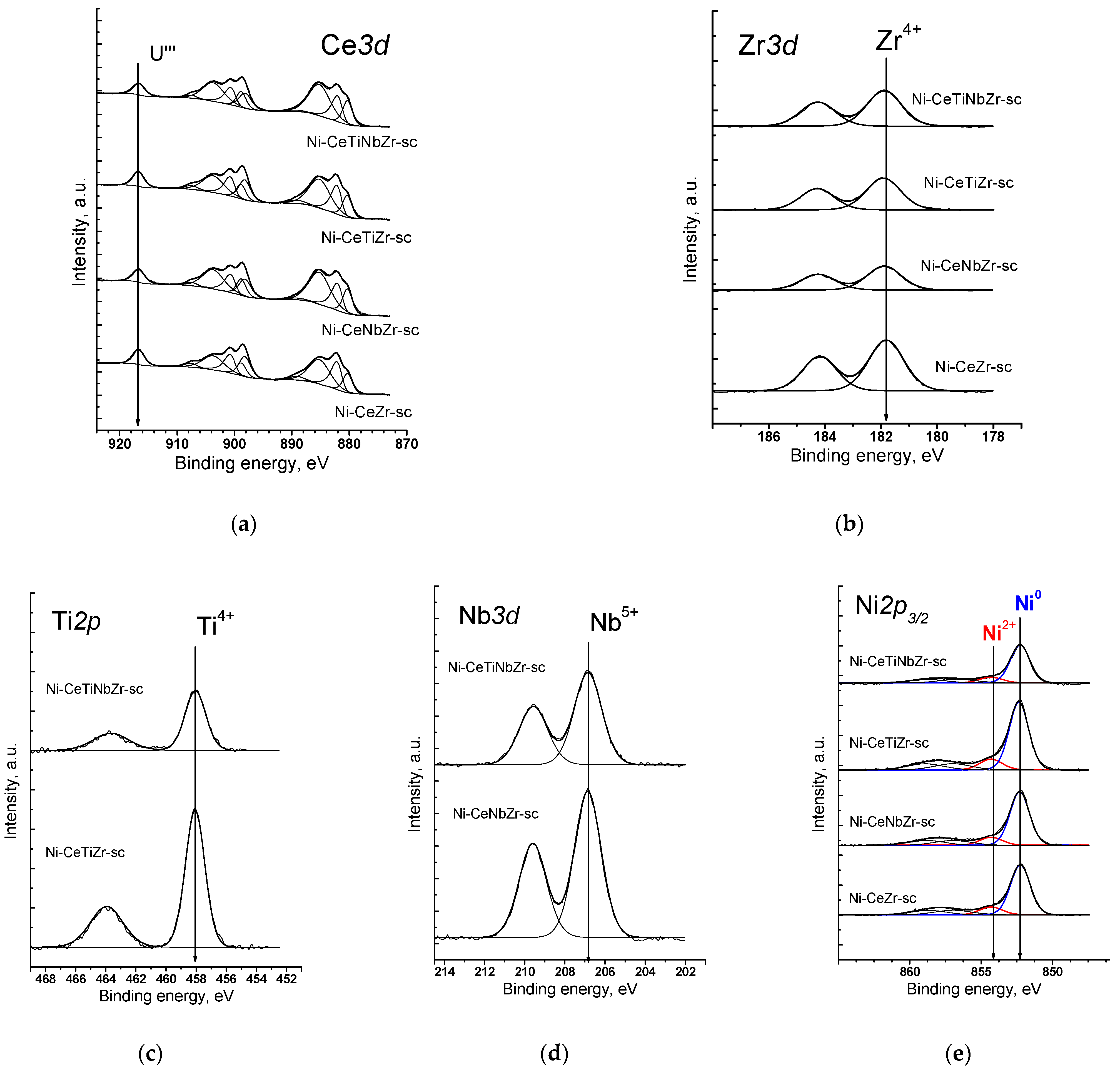


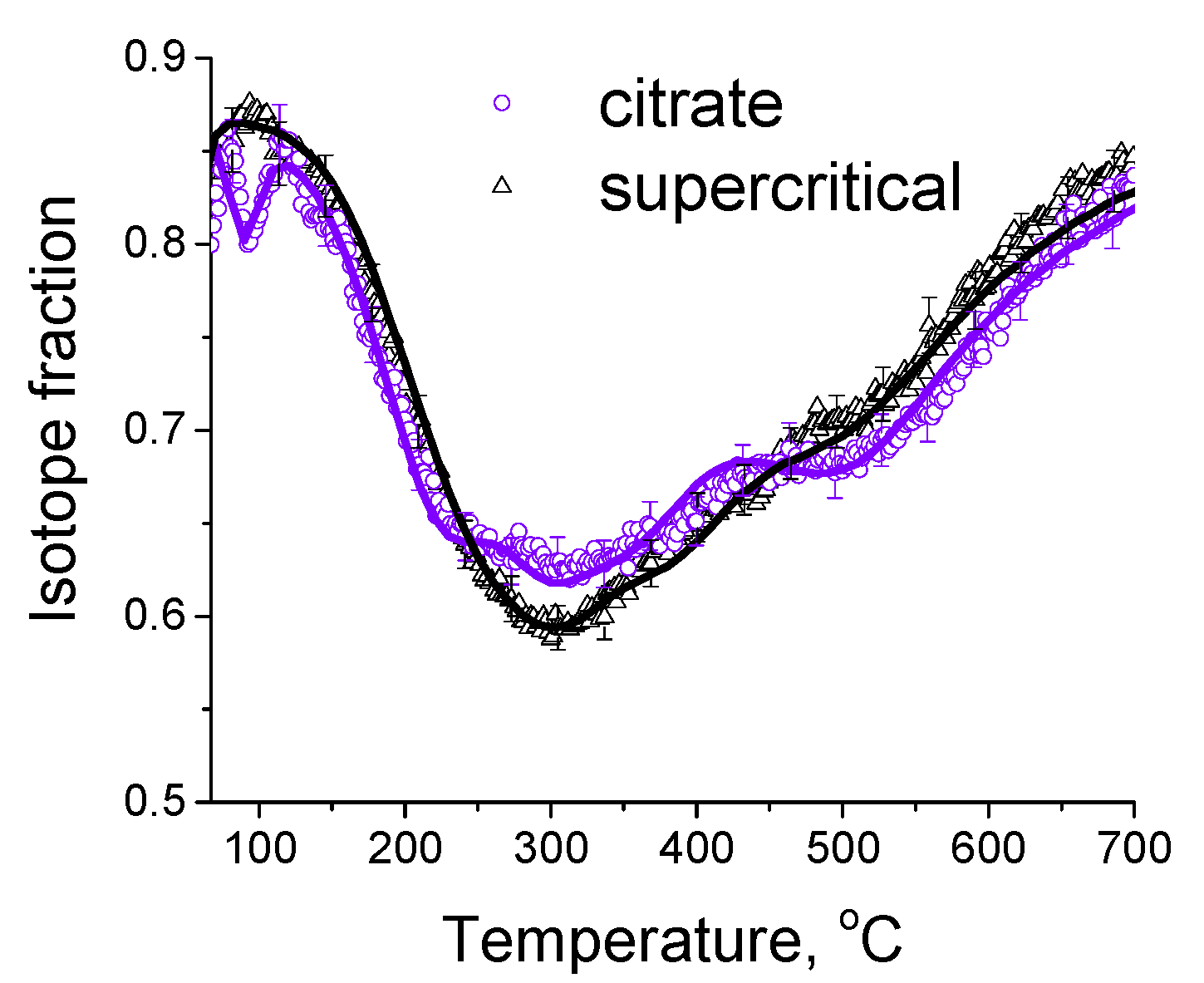
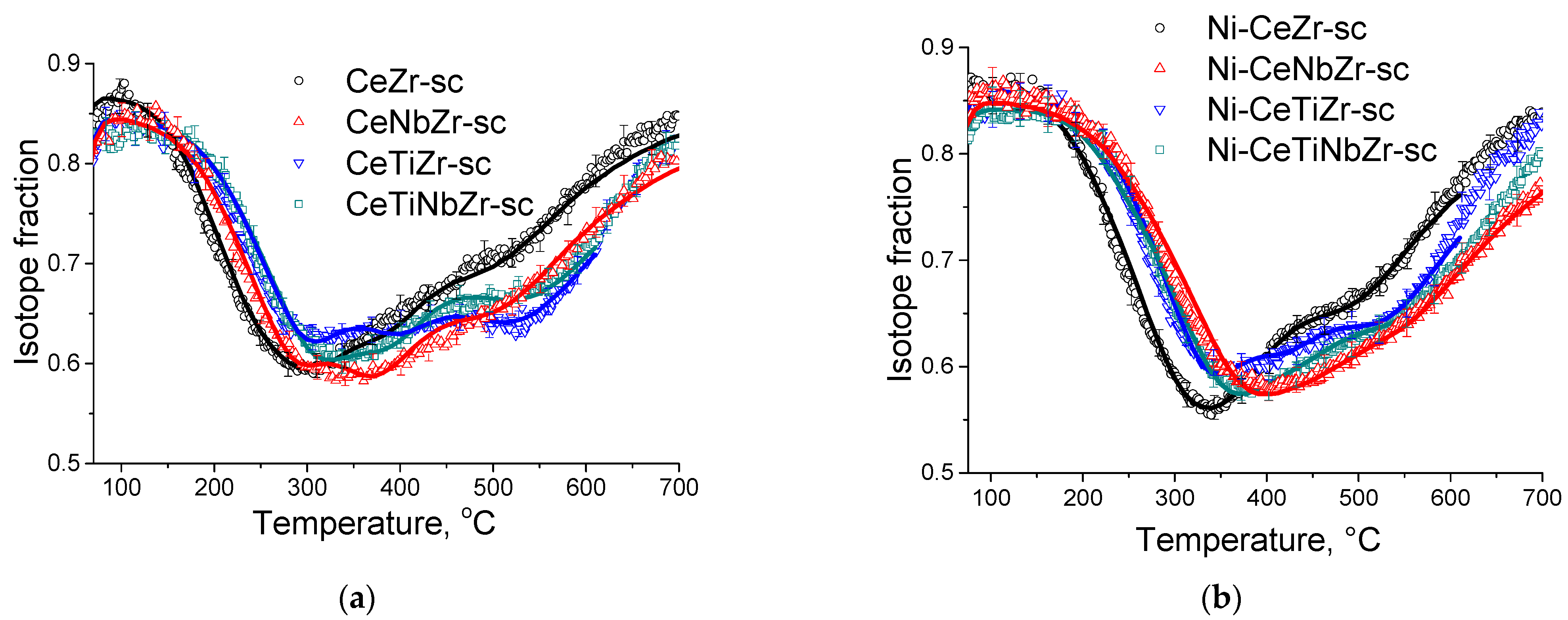
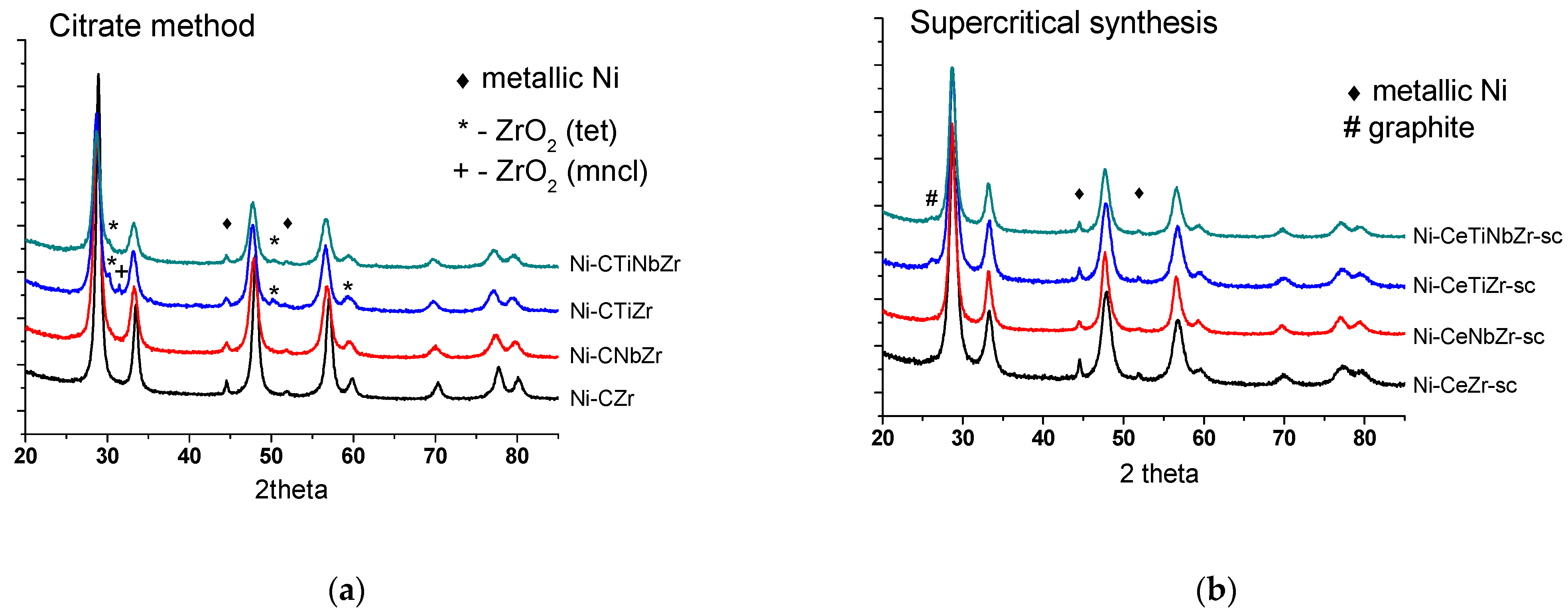
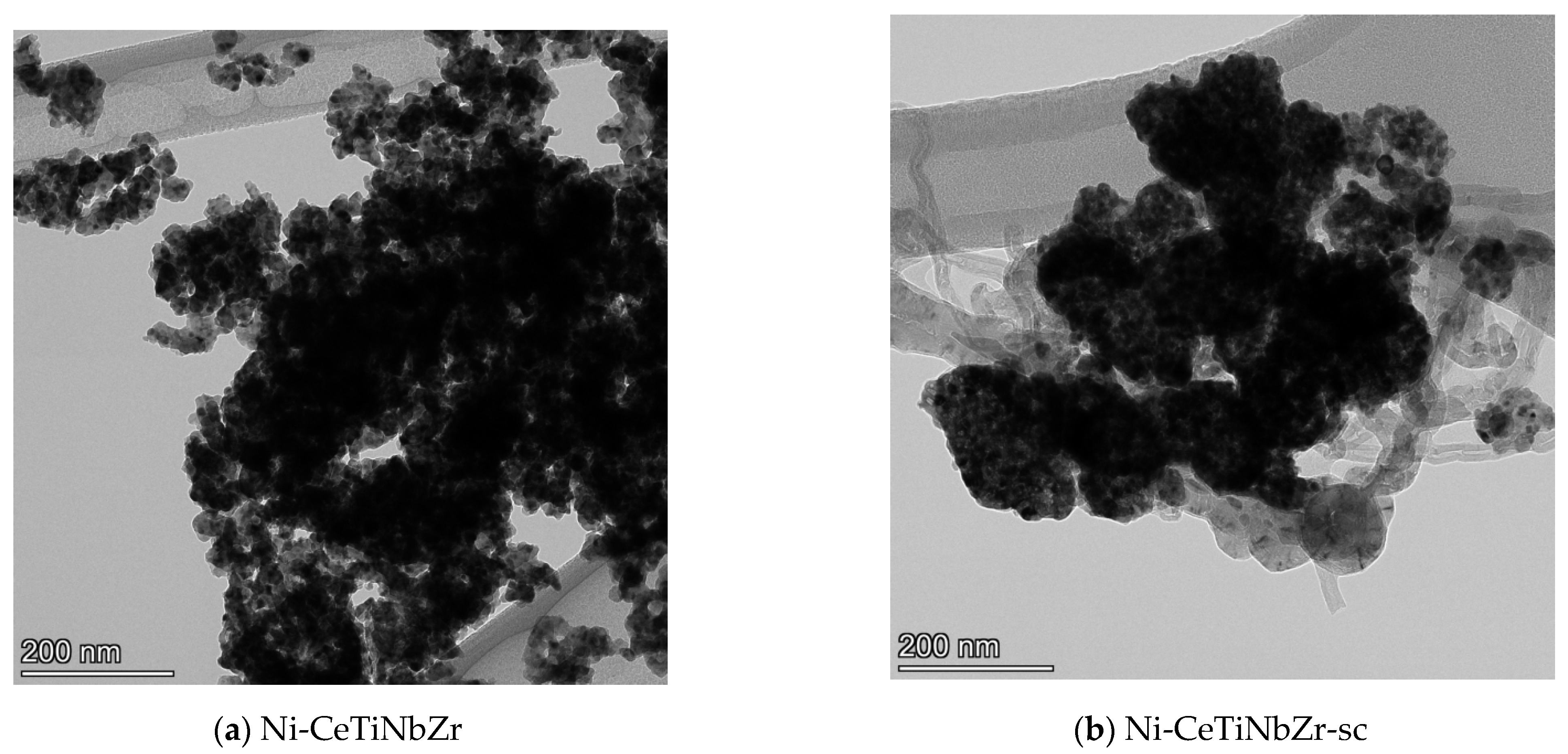
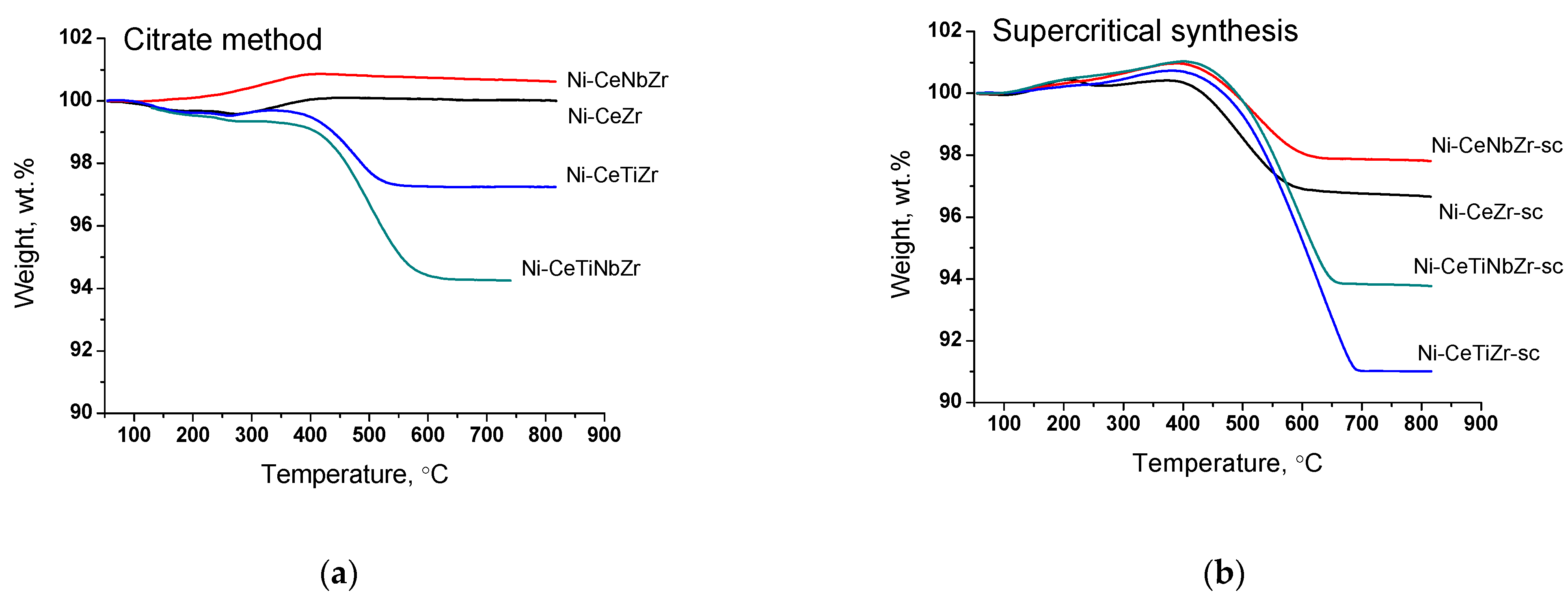
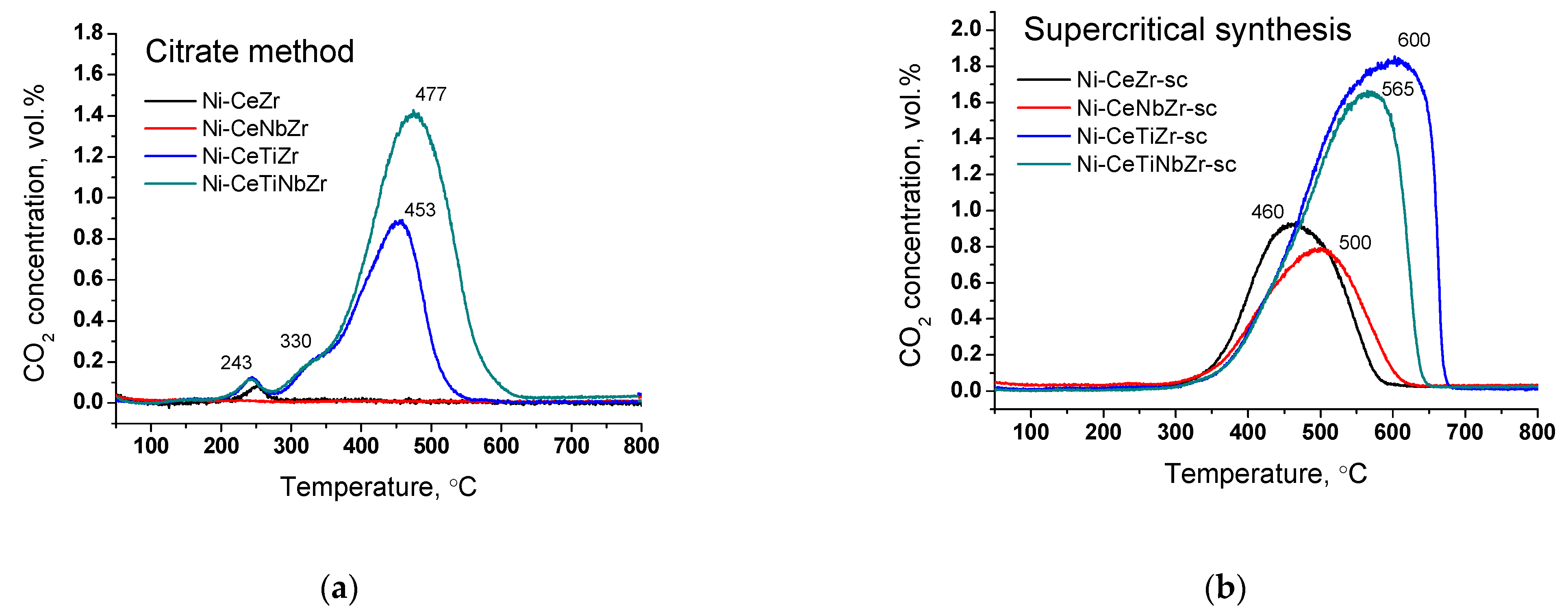
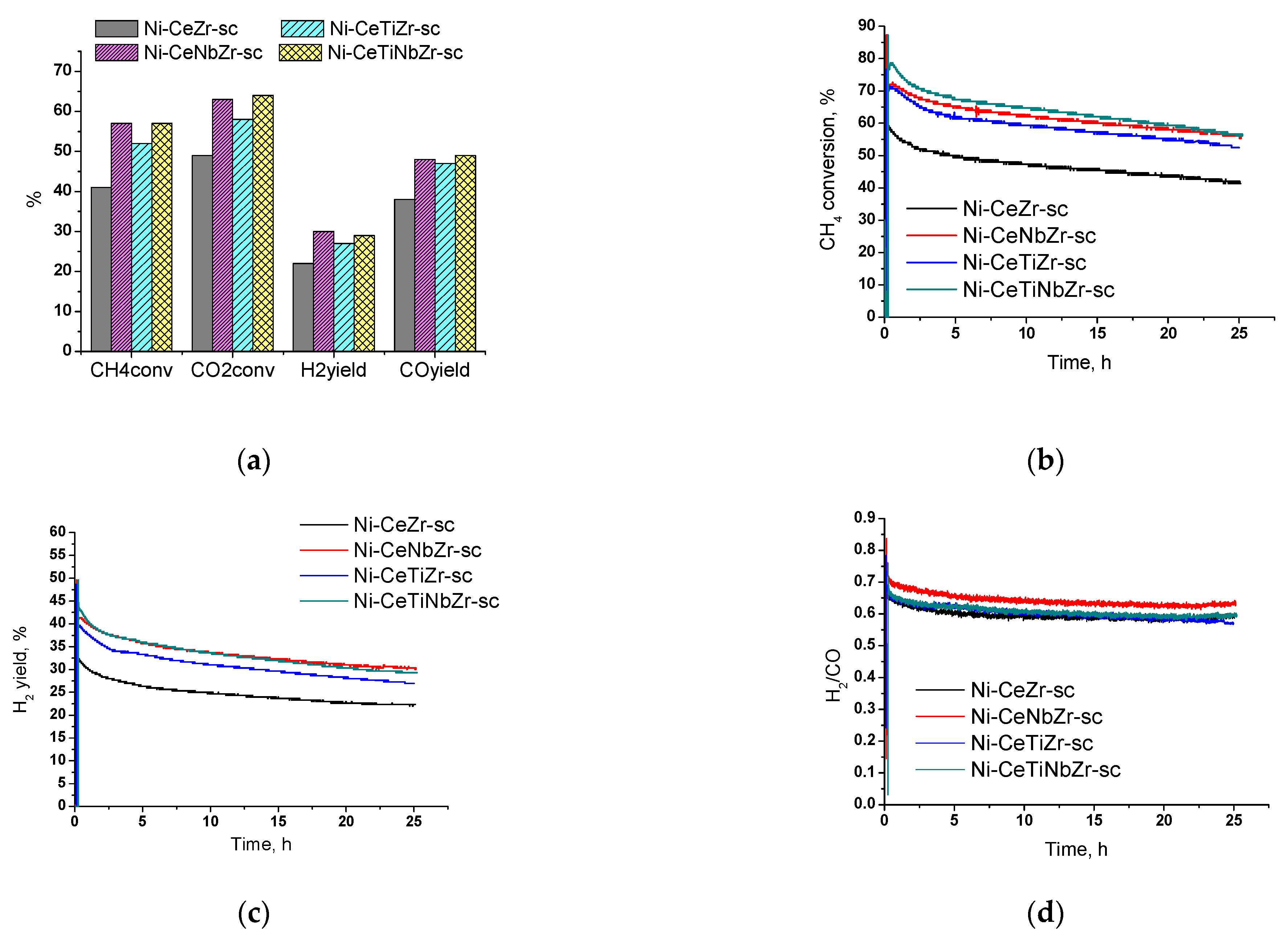
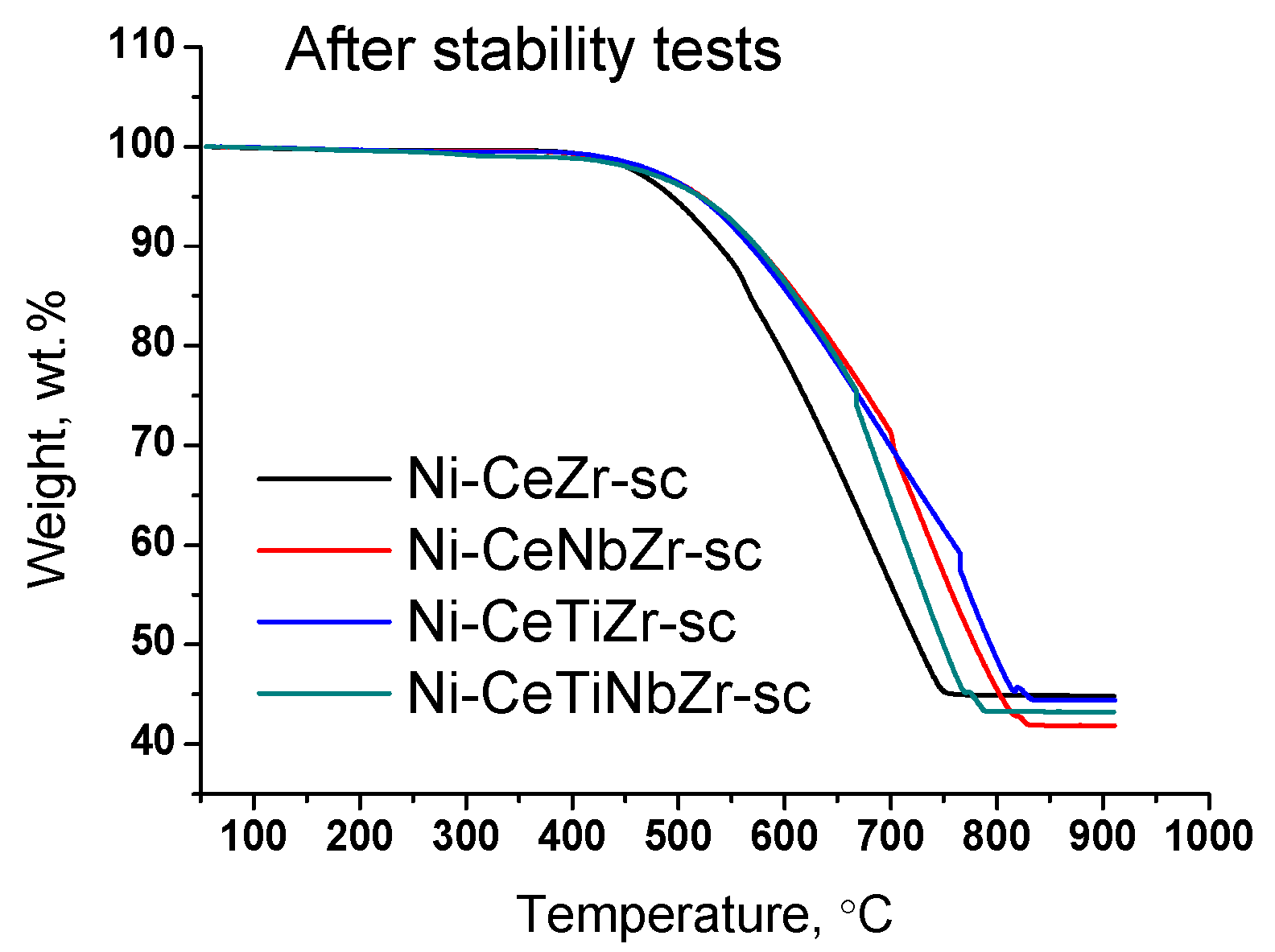
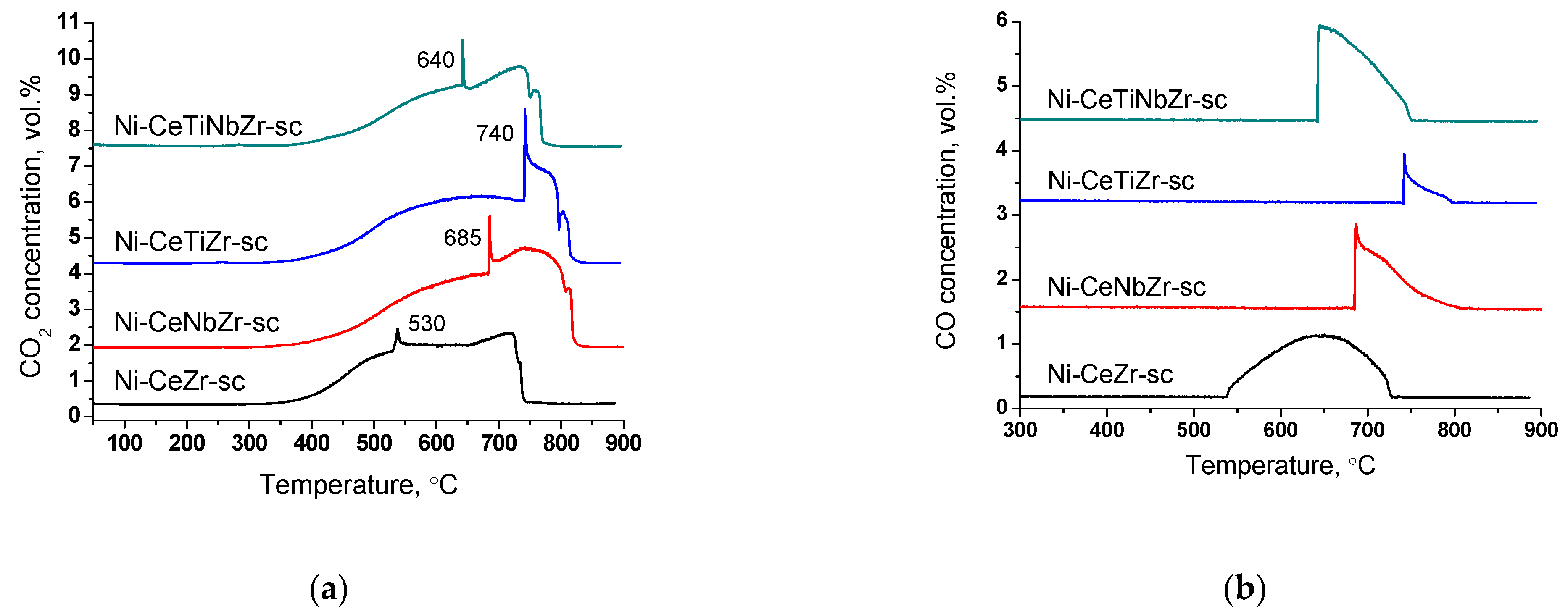
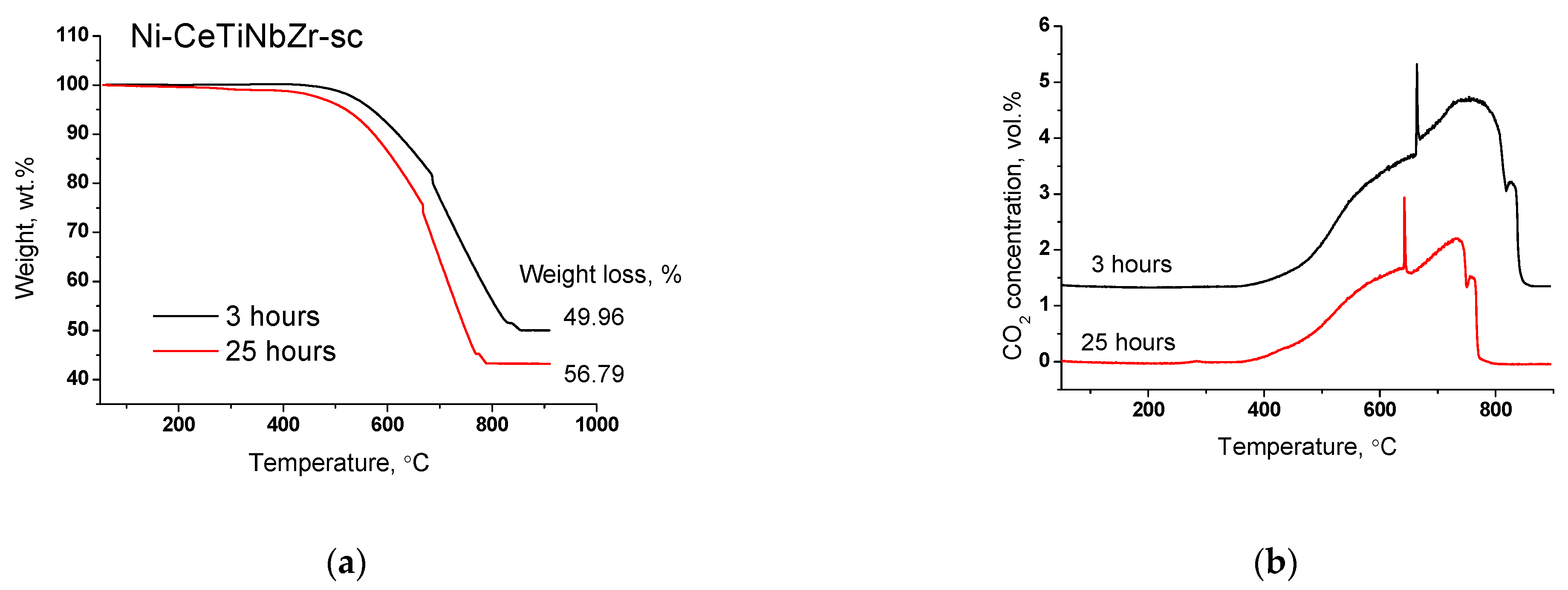
| № | Composition | Synthesis Method | |
|---|---|---|---|
| Citrate | Supercritical | ||
| 1 | 5%Ni/Ce0.75Zr0.25O2-δ | Ni-CeZr | Ni-CeZr-sc |
| 2 | 5%Ni/Ce0.75Nb0.1Zr0.15O2-δ | Ni-CeNbZr | Ni-CeNbZr-sc |
| 3 | 5%Ni/Ce0.75Ti0.1Zr0.15O2-δ | Ni-CeTiZr | Ni-CeTiZr-sc |
| 4 | 5%Ni/Ce0.75Ti0.05Nb0.05Zr0.15O2-δ | Ni-CeTiNbZr | Ni-CeTiNbZr-sc |
| Sample | Fresh | After Reaction | ||||||
|---|---|---|---|---|---|---|---|---|
| SBET, m2/g | Vtotal, cm³/g | d sup *, nm | d NiO **, nm | SBET, m2/g | Vtotal, cm³/g | d sup *, nm | d Ni **, nm | |
| Citrate method | ||||||||
| Ni-CeZr | 35 | 0.14 | 11 | 18 | 22 | 0.15 | 17 | 65 |
| Ni-CeNbZr | 29 | 0.11 | 11 | 24 | 28 | 0.13 | 11 | 23 |
| Ni-CeTiZr | 26 | 0.19 | 11 | 24 | 36 | 0.19 | 11 | 24 |
| Ni-CeTiNbZr | 28 | 0.21 | 11 | 18 | 30 | 0.24 | 11 | 52 |
| Supercritical synthesis | ||||||||
| Ni-CeZr-sc | 21 | 0.14 | 9 | 30 | 11 | 0.19 | 11 | 77 |
| Ni-CeNbZr-sc | 17 | 0.19 | 14 | 28 | 15 | 0.29 | 13 | 26 |
| Ni-CeTiZr-sc | 23 | 0.18 | 10 | 20 | 24 | 0.17 | 11 | 25 |
| Ni-CeTiNbZr-sc | 26 | 0.18 | 15 | 24 | 14 | 0.15 | 12 | 50 |
| Sample | [Ce]* | [Ce3+]/[Ce], % | [Ni] * | [Ni2+]/[Ni], % | [Ti] * | [Nb] * |
|---|---|---|---|---|---|---|
| Citrate method | ||||||
| Ni-CeZr | 0.70 | 59 | 0.08 | 12 | - | - |
| Ni-CeNbZr | 0.63 | 71 | 0.11 | 7 | - | 0.20 |
| Ni-CeTiZr | 0.74 | 62 | 0.10 | 10 | 0.08 | - |
| Ni-CeTiNbZr | 0.70 | 61 | 0.08 | 10 | 0.03 | 0.13 |
| Supercritical synthesis | ||||||
| Ni-CeZr-sc | 0.81 | 50 | 0.15 | 10 | - | - |
| Ni-CeNbZr-sc | 0.79 | 60 | 0.15 | 10 | - | 0.13 |
| Ni-CeTiZr-sc | 0.79 | 55 | 0.19 | 10 | 0.10 | - |
| Ni-CeTiNbZr-sc | 0.75 | 60 | 0.10 | 10 | 0.04 | 0.09 |
| Sample | νCO, cm− | Sites Amount, μmol/g | Bridging CO Amount, μmol/g | On-top CO Amount, μmol/g | Total Amount, μmol/g |
|---|---|---|---|---|---|
| Ni-CeZr | 1905 1954 1980 2027 2063 | 14 2 16 2 12 | 32 | 14 | 46 |
| Ni-CeZr-sc | 1839 1937 1955 1975 2047 2055 2080 | 0.1 17 4 3 9 2 5 | 24 | 16 | 40 |
| Ni-CeNbZr-sc | 1903 1953 2040 2057 2076 | 5 6 8 2 5 | 11 | 15 | 26 |
| Ni-CeTiZr-sc | 1917 1954 2032 2067 2079 | 8 1 7 4 0.3 | 9 | 11 | 20 |
| Ni-CeTiNbZr-sc | 1933 1949 2039 2067 2083 | 15 0.5 8 7 2 | 16 | 17 | 33 |
| Sample | S m2/g | L, 10−6 cm | (D/L2)over, 10−4 s−1 | Dover, 10−16 cm2/s | E kJ/mol | β | |
|---|---|---|---|---|---|---|---|
| Citrate method | |||||||
| CeZr | oxide | 44 | 0.9 | 52 | 42 | 75 | 38 |
| Supercritical synthesis | |||||||
| CeZr-sc | oxide | 29 | 1.5 | 22 | 43 | 75 | 13 |
| Ni/oxide | 21 | 2.0 | 5.9 | 24 | 77 | 9 | |
| CeNbZr-sc | oxide | 20 | 2.2 | 10 | 48 | 75 | 7 |
| Ni/oxide | 16 | 2.7 | 2.0 | 14 | 75 | 4 | |
| CeTiZr-sc | oxide | 28 | 1.6 | 4.9 | 12 | 75 | 33 |
| Ni/oxide | 23 | 1.9 | 2.8 | 9.7 | 85 | 14 | |
| CeTiNbZr-sc | oxide | 22 | 2.0 | 6 | 24 | 75 | 29 |
| Ni/oxide | 26 | 1.7 | 1.8 | 5.2 | 83 | 9 | |
| Sample | Temperature, °C | ||||||
|---|---|---|---|---|---|---|---|
| 600 | 650 | 700 | 750 | 700 | 650 | 600 | |
| Citrate method | |||||||
| Ni-CeZr | 17 | 27 | 37 | 48 | 33 | 22 | 13 |
| Ni-CeNbZr | 17 | 26 | 35 | 43 | 29 | 19 | 10 |
| Ni-CeTiZr | 17 | 27 | 36 | 43 | 29 | 18 | 10 |
| Ni-CeTiNbZr | 0 | 17 | 26 | 35 | 25 | 16 | 9 |
| Supercritical synthesis | |||||||
| Ni-CeZr-sc | 26 | 29 | 35 | 38 | 29 | 19 | 11 |
| Ni-CeNbZr-sc | 11 | 19 | 23 | 30 | 20 | 13 | 7 |
| Ni-CeTiZr-sc | 13 | 20 | 27 | 33 | 24 | 16 | 10 |
| Ni-CeTiNbZr-sc | 25 | 35 | 44 | 51 | 38 | 27 | 17 |
| Sample | Mass Loss, %TGA | |
|---|---|---|
| Temperature Tests | Long-Term Tests | |
| Citrate method | ||
| Ni-CeZr | 0 | - |
| Ni-CeNbZr | 0 | - |
| Ni-CeTiZr | 2.75 | - |
| Ni-CeTiNbZr | 5.80 | - |
| Supercritical synthesis | ||
| Ni-CeZr-sc | 3.34 | 55.20 |
| Ni-CeNbZr-sc | 2.19 | 58.13 |
| Ni-CeTiZr-sc | 8.99 | 55.61 |
| Ni-CeTiNbZr-sc | 6.24 | 56.79 |
Publisher’s Note: MDPI stays neutral with regard to jurisdictional claims in published maps and institutional affiliations. |
© 2022 by the authors. Licensee MDPI, Basel, Switzerland. This article is an open access article distributed under the terms and conditions of the Creative Commons Attribution (CC BY) license (https://creativecommons.org/licenses/by/4.0/).
Share and Cite
Smal, E.; Bespalko, Y.; Arapova, M.; Fedorova, V.; Valeev, K.; Eremeev, N.; Sadovskaya, E.; Krieger, T.; Glazneva, T.; Sadykov, V.; et al. Carbon Formation during Methane Dry Reforming over Ni-Containing Ceria-Zirconia Catalysts. Nanomaterials 2022, 12, 3676. https://doi.org/10.3390/nano12203676
Smal E, Bespalko Y, Arapova M, Fedorova V, Valeev K, Eremeev N, Sadovskaya E, Krieger T, Glazneva T, Sadykov V, et al. Carbon Formation during Methane Dry Reforming over Ni-Containing Ceria-Zirconia Catalysts. Nanomaterials. 2022; 12(20):3676. https://doi.org/10.3390/nano12203676
Chicago/Turabian StyleSmal, Ekaterina, Yulia Bespalko, Marina Arapova, Valeria Fedorova, Konstantin Valeev, Nikita Eremeev, Ekaterina Sadovskaya, Tamara Krieger, Tatiana Glazneva, Vladislav Sadykov, and et al. 2022. "Carbon Formation during Methane Dry Reforming over Ni-Containing Ceria-Zirconia Catalysts" Nanomaterials 12, no. 20: 3676. https://doi.org/10.3390/nano12203676
APA StyleSmal, E., Bespalko, Y., Arapova, M., Fedorova, V., Valeev, K., Eremeev, N., Sadovskaya, E., Krieger, T., Glazneva, T., Sadykov, V., & Simonov, M. (2022). Carbon Formation during Methane Dry Reforming over Ni-Containing Ceria-Zirconia Catalysts. Nanomaterials, 12(20), 3676. https://doi.org/10.3390/nano12203676







